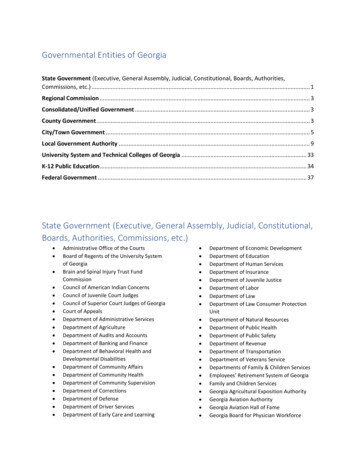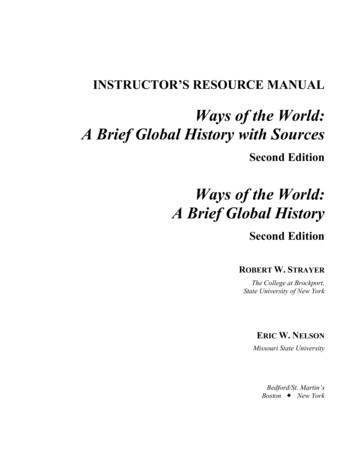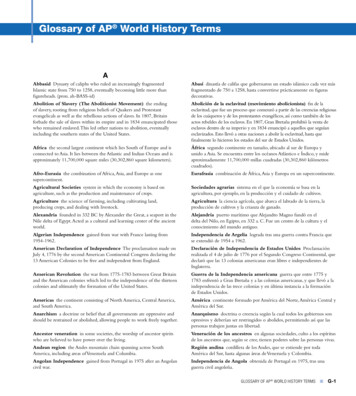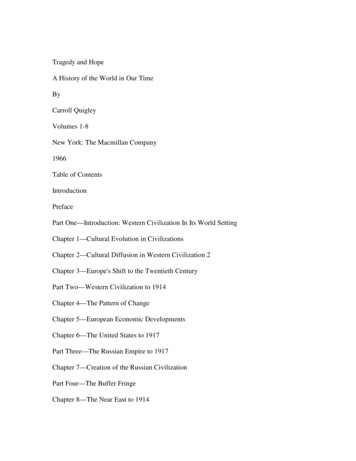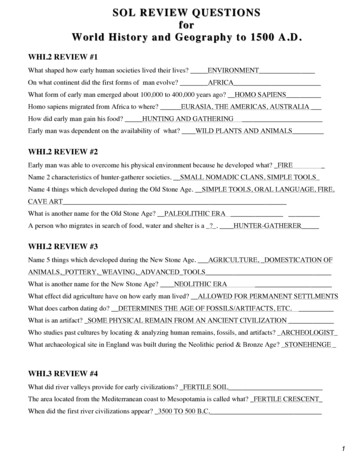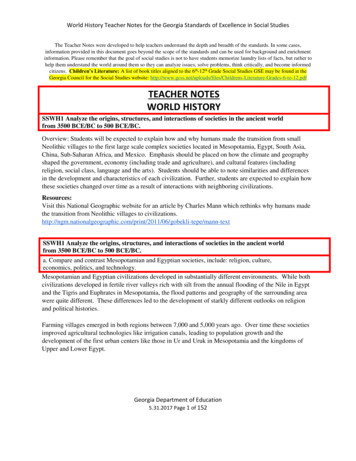
Transcription
World History Teacher Notes for the Georgia Standards of Excellence in Social StudiesThe Teacher Notes were developed to help teachers understand the depth and breadth of the standards. In some cases,information provided in this document goes beyond the scope of the standards and can be used for background and enrichmentinformation. Please remember that the goal of social studies is not to have students memorize laundry lists of facts, but rather tohelp them understand the world around them so they can analyze issues, solve problems, think critically, and become informedcitizens. Children’s Literature: A list of book titles aligned to the 6th-12th Grade Social Studies GSE may be found at theGeorgia Council for the Social Studies website: ture-Grades-6-to-12.pdfTEACHER NOTESWORLD HISTORYSSWH1 Analyze the origins, structures, and interactions of societies in the ancient worldfrom 3500 BCE/BC to 500 BCE/BC.Overview: Students will be expected to explain how and why humans made the transition from smallNeolithic villages to the first large scale complex societies located in Mesopotamia, Egypt, South Asia,China, Sub-Saharan Africa, and Mexico. Emphasis should be placed on how the climate and geographyshaped the government, economy (including trade and agriculture), and cultural features (includingreligion, social class, language and the arts). Students should be able to note similarities and differencesin the development and characteristics of each civilization. Further, students are expected to explain howthese societies changed over time as a result of interactions with neighboring civilizations.Resources:Visit this National Geographic website for an article by Charles Mann which rethinks why humans madethe transition from Neolithic villages to int/2011/06/gobekli-tepe/mann-textSSWH1 Analyze the origins, structures, and interactions of societies in the ancient worldfrom 3500 BCE/BC to 500 BCE/BC.a. Compare and contrast Mesopotamian and Egyptian societies, include: religion, culture,economics, politics, and technology.Mesopotamian and Egyptian civilizations developed in substantially different environments. While bothcivilizations developed in fertile river valleys rich with silt from the annual flooding of the Nile in Egyptand the Tigris and Euphrates in Mesopotamia, the flood patterns and geography of the surrounding areawere quite different. These differences led to the development of starkly different outlooks on religionand political histories.Farming villages emerged in both regions between 7,000 and 5,000 years ago. Over time these societiesimproved agricultural technologies like irrigation canals, leading to population growth and thedevelopment of the first urban centers like those in Ur and Uruk in Mesopotamia and the kingdoms ofUpper and Lower Egypt.Georgia Department of Education5.31.2017 Page 1 of 152
World History Teacher Notes for the Georgia Standards of Excellence in Social StudiesFertile Regions of Egypt and MesopotamiaMesopotamia developed in the fertilearch (known as the Fertile Crescent)along the Tigris and Euphrates riversthat runs from the Persian Gulf in thesouth to the Mediterranean Sea in thenorth. This desert region is prone toirradiate flooding and lacks naturalboundaries, making it susceptible tofrequent invasions. Egypt on the otherhand developed in the narrow fertileribbon on the banks of the Nile River.The Nile floods with remarkableregularity from July to October of eachyear. Each time depositing rich silt thatwas ideal for agriculture, this regularitywas known as the Gift of the Nilewhich led to remarkable stability inEgyptian society. Another factor thatcontributed to this stability includednatural boundaries that made invasionsunusual. To the north and east largebodies of water protected Egypt and tothe south and west vast deserts.These environmental differences led to starkly different outlooks of religion. Both the Egyptians andMesopotamians were polytheistic with Gods that represented elements of nature, but because the naturalworld of each civilization was so different, attitudes toward these Gods were quite different. In generalthe Gods of Mesopotamia were viewed as unpredictable and often elicited the fear of the populationwhich tried to win their approval with sacrifices and the construction of elaborate temples calledZiggurats. Egyptian religion on the other hand, presented Gods that could be depended on to providebounty and prosperity. This difference was also reflected in each civilization’s view of the afterlife.Mesopotamians believed that the afterlife was a fearful and gloomy place while Egyptians believed thatgood deeds in life were rewarded with an afterlife rich in the same pleasures they enjoyed while alive.These Egyptian views on death and the afterlife led to elaborate burial practices that included theconstruction of tombs and mummification.Environmental difference also led to remarkably different political histories with Mesopotamia marked byfrequent change and Egypt experiencing substantial continuity. The first phase of Mesopotamia’spolitical history, known as Sumer, was dominated by several independent and often warring city-states,each with its own hereditary monarch. Each city-state had a walled urban area made up of simple mudbrick dwellings and a ceremonial and administrative center dominated by a Ziggurat. Outside of the citywalls, each city-state controlled the large areas of surrounding farmland land. Around 4,000 years ago theKing of Akkad, Sargon, conquered this region creating the world’s first empire. This empire wasGeorgia Department of Education5.31.2017 Page 2 of 152
World History Teacher Notes for the Georgia Standards of Excellence in Social Studiesrelatively short lived as several waves of invasions and insurrection shifted political power to othergroups. One of these groups, the Babylonians brought important political innovation when they unifiedthe region in the 18th century BCE. The Babylonian King Hammurabi introduced the World’s firstwritten law code which limited the arbitrary justice of earlier kings. The Old Babylonian Empire as it isknown by historians also witnessed a flowering in mathematics and literature. However, like theMesopotamian empires that came before, Babylonians succumb to invasion leading to a series of warringempires. These empires included the Hittites, an Indo-European speaking people who arrived in theregion about 2000 BCE bringing iron technology, the Assyrians who rose in power around 1900 BCE,and the Persians who began to build a long-lived empire around 550 BCE.Egypt, protected by vast desert and seas, saw far fewer invasions and as a result had a remarkably stablepolitical history for over 2,000 years. This history began about 3,000 BCE with the unification of Upperand Lower Egypt into a single kingdom ruled by a divine hereditary monarch known as the Pharaoh. ThePharaohs were aided by an elaborate bureaucracy that included priests, administrators and scribes. Thisgovernment was able to undertake elaborate public works projects like the construction of Pyramids thatserved as tombs for the Pharaoh. Historians divide Egyptian History into the Old Kingdom (c. 2649 to2150 BCE), the First Intermediate Period, Middle Kingdom (c. 2030-1640 BCE), the Second IntermediatePeriod, and the New Kingdom (c. 1550-1070). The intermediate periods mark the only major timesinstability in Egypt before 1070 BCE. During the Second Intermediate Period, Egypt experienced its firstmajor invasion from the Hyksos of Mesopotamia who introduced the region to the horse, chariot andcompound bow. After 1070, the political histories of Egypt and Mesopotamia intersected as they bothexperienced invasions from groups like the Hittites (who introduced Iron to the region), Assyrians andPersians.Fertile river valleys combined with technological advances like irrigation canals and plows allowed bothMesopotamia and Egypt to produce surplus food. With an agricultural surplus, both empires developedspecialization of labor which in turn led to the development of social classes. Both societies had the samebasic social hierarchy with the royal family at the top followed by priests, government officials,landowners, soldiers, and scribes constituting a ruling class followed by merchants and artisans in themiddle and peasant farmers at the bottom. Mesopotamia tended to rely more heavily on slaves but Egyptdeveloped a slave class made up mostly of foreigners later in its history. This specialization of laborallowed both societies to make notable cultural and technological advances. Both Mesopotamia andEgypt developed complex systems of writing, cuneiform and hieroglyphics respectively. Both alsodeveloped advanced literary, artistic and architectural traditions including The Epic of Gilgamesh fromMesopotamia.Resources:Visit this global virtual museum of Egyptian artifacts.http://www.globalegyptianmuseum.org/Read the article below for an excellent summary of Mesopotamian history.http://www.shsu.edu/ his ncp/Iraq.htmlGeorgia Department of Education5.31.2017 Page 3 of 152
World History Teacher Notes for the Georgia Standards of Excellence in Social StudiesSSWH1 Analyze the origins, structures, and interactions of societies in the ancient worldfrom 3500 BCE/BC to 500 BCE/BC.b. Describe the societies of India and China, include: religion, culture, economics, politics, and technology.Farming villages first appeared in South Asia about 3200 BCE in the fertile plain between the Indus andGanges rivers. This region’s climate is dominated by monsoon rains and a wall of mountains to the northand west partially isolate its people. Urban centers appeared about 2500 BCE with Mohenjo-Daro andHarappa being the most significant.Panoramic view of the stupa mound and great bath in Mohenjo-Daro, by Saqib Qayyum 8 March 2014Little is known about these early civilizations because historians are unable to read the written languageof the region but urban planning in Mohenjo-Daro and Harappa indicate the presence of a strong centralgovernment. The cities were elevated and surrounded by earthen walls and levees to protect them fromflooding. Inside the walls, the streets were laid out on a grid system. Homes were constructed of bakedbrick, each with its own bathroom served by a city-wide sewer and plumbing system. Each city had afortified citadel in the center which likely served as the political and religious center. Archaeologist havefound a large number of children’s toys and few weapons, indicating that these societies were generallypeaceful. The economy was dependent on agriculture with evidence of trade with the Middle East andCentral Asia.Urban decay, possibly brought on by earthquakes and soil exhaustion set in around 1750 BCE. A newgroup of people, the Indo-European Aryans, migrated into the region in about 1500 BCE. This groupeventually established the Magadha Kingdom which controlled a portion of northeast India by the secondcentury BCE.The farming villages between the Huang He and Yangtze Rivers of China grew into cities about 2000BCE. These urban areas both benefited from and suffered because of the rich but loose yellow silt calledloess deposited by the flooding of Yangtze. While the soil supported agriculture its loose nature mademajor shifts in the course of the river and massive floods common. These struggles are recorded inChinese legend as the Xia Dynasty whose Emperor Yu is said to have brought flood control and irrigationto China.Georgia Department of Education5.31.2017 Page 4 of 152
World History Teacher Notes for the Georgia Standards of Excellence in Social StudiesThe first documented dynasty of China was the Shang which was founded about 1700 BCE. This dynastystarted a long tradition of governance in China that included a hereditary monarch supported by acomplex bureaucracy.Like other early civilizations, during the Shang period urban centers were walled and surrounded by largeagricultural areas. While the economy was dominated by agriculture, craft production and trade were alsopresent. China developed a writing system, complex urban planning, irrigation and flood control in thisperiod.This period also saw the emergence of foundational and interconnected Chinese religious principles.These include concept of Yin and Yang which offered an early and enduring understanding of theuniverse as balanced between male and female forces. Daoism, founded by Lao Tsu, asked humanity torespect and live in harmony with nature and ancestor worship venerated deceased family members in thehope that they would intercede with the powers in Heaven on behalf of the living.Resources:Visit this site for a primary source reading on the concept of Yin and nyang.htmVisit this website to read a speech by Mao Sewei, Consul General of China, discussing China and India,related yet different ng/zlgxw/t676806.htmGeorgia Department of Education5.31.2017 Page 5 of 152
World History Teacher Notes for the Georgia Standards of Excellence in Social StudiesSSWH1 Analyze the origins, structures, and interactions of societies in the ancient worldfrom 3500 BCE/BC to 500 BCE/BC.c. Explain the development of monotheism, include: the concepts developed by the ancientHebrews.While aspects of monotheism emerged in a variety of places and times including in Egypt under thePharaoh Amenhotep IV in the mid-1300s BCEand in Persia after growth of Zoroastrianism inthe 600s BCE, monotheism reached its mostcomplete and enduring form among the Hebrewsstarting around 1250 BCE.These beliefs, recorded in the Hebrew Bible,begin with the Hebrew people (led by Moses)entering into a covenant with God in which Godpromises to protect His chosen people inexchange for their exclusive obedience to Him.The basic tenants and Judaism, includingmonotheism, were established in this period asthe Ten Commandments.The Hebrew people established a kingdom on theeastern Mediterranean in about 1020 BCE whichsplit into two kingdoms in 920 BCE. Theconcept of monotheism became more formalizedduring this period and was spread to other areasby the Jewish diaspora that began with theconquest of the northern Kingdom of Israel bythe Assyrians in 721 BCE and the deportation ofmany Jewish leaders to Babylonia in 587 BCE.Hebrew KingdomsWhile in Babylonia, the institution of theSynagogue was established and in about 450BCE Judaism as a monotheistic faith was fully developed with the completion of the Hebrew Bible.Resources:Visit this Utah State University website for information on the development of monotheism in apters/10AKHEN.htmGeorgia Department of Education5.31.2017 Page 6 of 152
World History Teacher Notes for the Georgia Standards of Excellence in Social StudiesSSWH1 Analyze the origins, structures, and interactions of societies in the ancient worldfrom 3500 BCE/BC to 500 BCE/BC.d. Identify the Bantu migration patterns and contribution to settled agriculture.Agricultural villages became common in West Africa below the Sahara desert about 4,000 years ago.Sometime after, these villages developed iron technology which they used to produce tools of agriculture.Extensive linguistic evidence suggests that West Africans from around the modern border betweenNigeria and Cameroon began to use this technology to clear forest to the southeast for farming. This ledto a slow migration of these Bantu speaking people to the southeast and south from about 500 BCE to 600CE. This migration brought agriculture, iron technology, and a new language to a region previouslydominated by hunter gathers. Anthropologist believe that this migration laid the foundation for acommon cultural heritage present in much of West, Central, East and South Africa.Resources:Read more about the Bantu expansion in the following article.http://pages.ucsd.edu/ tmlGeorgia Department of Education5.31.2017 Page 7 of 152
World History Teacher Notes for the Georgia Standards of Excellence in Social StudiesSSWH1 Analyze the origins, structures, and interactions of societies in the ancient worldfrom 3500 BCE/BC to 500 BCE/BC.e. Explain the rise of the Olmecs.Civilizations also developed in the Americas in this period. Geographic isolation made them moreunique but they followed many of the same patterns of civilizations in Afro-Eurasia.Agricultural villages based on the cultivation of corn, beans, and squash emerged about 3500 BCE.These villages grew into a variety of urban centers around 1200 BCE, the most influential of which wasthe Olmec culture found in the modern Mexican states of Veracruz and Tabasco.Political authority and social stratification developed in these urban areas as a result of agriculturalsurplus and the need to mobilize large numbers of people to construct irrigation systems, ceremonialbuildings and to drain land for farming.Sophisticated urban planning based on the movement of the stars, the creation of monumental artworkincluding several giant Olmec head statues, and theconstruction of monumental architecture indicate astrong central government able to mobilize the laborof the population over time. Each Olmec city waslikely independently ruled by a hereditary monarchwho maintained power by presenting himself as anintermediary to the gods. These rulers, assisted by aclass of priests, performed awe inspiring rituals onlarge platforms in the center of each city thatincluded bloodletting and human sacrifice. Theserituals served to reinforce the power of the state andlaid the cultural foundations for the civilization thatfollowed.Olmec Head StatueThe Olmec economy like other ancient civilizationswas dominated by agriculture but sophisticated tradenetworks and craft production also existed.Resources:Visit the British Museum website for more information about the Olmec s/lost kingdoms central america/olmec.aspxGeorgia Department of Education5.31.2017 Page 8 of 152
World History Teacher Notes for the Georgia Standards of Excellence in Social StudiesTEACHER NOTESWORLD HISTORYSSWH2 Identify the major achievements of Chinese and Indian societies to 500 CE/AD.Overview: Students will be expected to explain the development of the Classical Age societies of Chinaand India with a special attention to the religious, philosophical, and political developments that left anenduring legacy. Focus should be placed on the changes and continuities each region experienced in thetransition from small regional kingdoms to large multi-ethnic empires. Further, students are expected toexplain how trade routes connected these empires to the outside world which fostered cultural, economicand technological development.SSWH2 Identify the major achievements of Chinese and Indian societies to 500 CE/AD.a. Describe the development of Indian civilization, include: the rise and fall of the Mauryaand Gupta Empires.The Maurya (324 BCE to 184 BCE) were the first empire to unify large areas of India. There is someevidence that the founding emperor Chandragupta Maurya may have been inspired by Alexander theGreat whose death left a political vacuum in Northwest India that the Maurya filled. The empire wasruled by a hereditary monarch aided by an elaboratebureaucracy made up of relatives and close associateswho governed ethnicity based regional provinces. Thecentral government was able to collect high taxes, issuea standard currency and maintain control of mining.This was facilitated by an extensive network of spiesthat kept the central government aware of disloyalty.Further, a powerful standing army that includedelephant, chariot, and cavalry divisions helped securethis power.While agriculture remained the primary economicactivity, an extensive network of roads and maritimeconnections to Southeast Asia and the Middle Eastfoster both internal and international trade. Indiaprofited from the export of cotton cloth, iron, and salt.In 269 BCE the Emperor Ashoka came to powerushering in a period of religious pluralism andtolerance. As a young man, Ashoka engaged inviolent wars of conquest. Guilt associated with thisviolence drove Ashoka to convert to Buddhism. As aBuddhist emperor, he made it state policy to promoteCapital of inscribed Ashoka Pillar, Photo by AS Mysore,Buddhism throughout his empire by erecting pillars1911that promoted the teachings of the Buddha. This policywas an important factor in ensuring the longevity of Buddhism as a major world religion.Georgia Department of Education5.31.2017 Page 9 of 152
World History Teacher Notes for the Georgia Standards of Excellence in Social StudiesThe Maurya Empire fell in 184 BCE as a result of dynastic disputes and invasions by outside enemies.Following a period of political disunity, the Gupta Empire came to power in 320 CE, ruling a portion ofNorth Central India. The founder, Chandra Gupta modeled his rule on that of the Maurya. While theGupta were able to collect high taxes, demand labor from subjects for state projects, and control metalmining and salt production they were never able to maintain the level of central authority that the Mauryaenjoyed. Regional hereditary governors were only nominally under the control of the central governmentforcing the emperor to rely on diplomacy to maintain the unity of the empire.Hinduism enjoyed a resurgence during the Gupta period leading to the strengthening of the Caste Systemand the intensification of patriarchy. The tradition of sati, widows throwing themselves on the funeralpyre of their late husbands, became common. Internal and international trade continued to flourish andmajor advances in mathematics were realized, including the development of the decimal system, Arabicnumerals (wrongly named because of their diffusion to Europe through the Middle East), and pi.The Gupta Empire fell in the 500s CE largely as a result of nomadic invaders from the northwest.Resources:Visit this Colorado State University site for an explanation and the primary source text of the Edicts ofAshoka.http://www.cs.colostate.edu/ malaiya/ashoka.htmlGeorgia Department of Education5.31.2017 Page 10 of 152
World History Teacher Notes for the Georgia Standards of Excellence in Social StudiesSSWH2 Identify the major achievements of Chinese and Indian societies to 500 CE/AD.b. Describe the development of Chinese civilization under Zhou, Qin, and Han.Fundamental elements of Chinese governance came with the second Dynasty, the Zhou (1027 to 221BCE). These principles include the Mandate of Heaven which argues that the ruling dynasty has beencharged by Heaven to rule the people with benevolence (called the Dao) and Confucianism. WhileConfucianism did not have a profound political impact until about 200 BCE the basic tenants of filialpiety, adherence to tradition, patriarchy and duty were established during the Zhou dynasty. The Zhouwere only able to maintain centralized authority until about 800 BCE, after that they relied on a system offeudalism to administer the empire and by 480 BCE civil war thrust China into the Warring States Period.This conflict lasted until the Shi Huangdi emerged victorious and established the Qin Dynasty.During these years of conflict a new governing philosophy emerged in China called Legalism.Proponents of Legalism argued that humans were innately self-serving and destructive therefore societalorder had to be maintainedwith strict laws and harshpunishments. Shi Huangdi,prescribed to these beliefs andbuilt a highly centralizedbureaucracy around thesetenants. While the QinDynasty was short-lived it isgiven credit for unifying Chinapolitically, economically, andculturally. Under the Qin,weights, measures, coinage,laws, writing, and axle lengthwere all standardized. Thestate directed the constructionof extensive roads and canals,work on the Great Wall ofTerracotta Army that surrounds the tomb of Shi HuangdiChina began, and land reformbroke up the power of feudal lords. These reforms laid the foundations for the effective administration ofthe vast empires of the dynasties that followed.The extensive use of forced labor and excessive taxation quickly led to rebellion after the death of ShiHuangdi in 210 BCE. Out of these rebellions, a peasant named Liu Bang emerged as the new emperor ofChina and established the Han Dynasty. The Han Dynasty maintained many of the policies of the Qin buttempered the severity of Legalism with the political use of Confucianism which required leaders to earnthe respect of the governed. This combination proved durable and long-lived.The Han were able to maintain control of an empire even larger than the Qin. From their capital inChang’an, the Han directed a vast bureaucracy organized into nine ministries and regional authorities.Georgia Department of Education5.31.2017 Page 11 of 152
World History Teacher Notes for the Georgia Standards of Excellence in Social StudiesThis bureaucracy was staffed by educated civil servants who received their appointments based on theirscore on a rigorous civil service examination. The state operated an effective tax collection system, apostal service, built extensive roads, canals, and defensive walls, and protected the empire from theconstant threat of nomadic invaders from the north.The security of the Han period led to a thriving economy that engaged in extensive internal andinternational trade, profiting tremendously from the export of silk. Economic growth was also aided byadvancements in farm technology like the horse collar and better irrigation.The Han Dynasty began to decline around 200 CE, contributing factors included: bureaucratic corruptionand infighting, food shortages, epidemic disease, banditry, and pressure from nomadic invaders along thenorthern border.Resources:Visit the website for more information on early China.http://www.shsu.edu/ his ncp/China1.htmlVisit this Asia for Educators site from Columbia University for notes on the Qin and Han Dynasties.http://afe.easia.columbia.edu/main pop/kpct/kp qinhan.htmGeorgia Department of Education5.31.2017 Page 12 of 152
World History Teacher Notes for the Georgia Standards of Excellence in Social StudiesSSWH2 Identify the major achievements of Chinese and Indian societies to 500 CE/AD.c. Explain the development and impact of Hinduism and Buddhism on India, andConfucianism on China.Indo-European religious traditions, preserved in the the Vedas, blended with the indigenous traditions ofthe Dravidian population to create a nascent form of Hinduism. These religious traditions began toformalize around 750 to 550 BCE with the writing of the Upanishads. This faith centered on the basicbelief that all living things are reincarnated after death with the quality of the next life based on the deeds(Karma) of the individual in the previous life. Humans are expected to live according to the Dharma andgood conduct is rewarded with an eventual release from the cycle of reincarnation called Moksha.This faith, combined with the dominance of the Indo-European Aryans over the indigenous Dravidiansled to the creation of a rigid social class system called Caste or Varna. The population was divided intofive hereditary social classes based on ethnicity and occupation.Hinduism fully developed during the GuptaDynasty (320 CE to 550 CE). During thisperiod the hereditary nature of theoccupational classes of the Caste System,patriarchy, the belief in a pantheon of Gods,a rich tradition of epic literature and theconstruction of monumental Hinduarchitecture became commonplace. Thesetraditions, established Gupta Dynasty,endured for centuries among the populationof South Asia.Hinduism’s dominance in the region waschallenged by the emergence of new faithsincluding Jainism and Buddhism in aroundBrahman Priest Painting His Forehead, from the Frank and Frances500 BCE. While Buddhism had littleCarpenter Collection at the Library of Congresssuccess in gaining adherents in South Asia itdid spread along trade routes and become a major faith in East and Southeast Asia. Buddhism wasfounded by a Hindu prince named Siddhartha Gautama who rejected the caste system and the pantheon ofHindu Gods and taught instead that spiritual enlightenment (Nirvana) and escape from the cyclereincarnation could be reached in a single lifetime by accepting the Four Noble Truths and following theEightfold Path.In the period after c. 500 BCE Buddhism offered an alternative to the sometimes oppressive nature ofHinduism's caste system and patriarchal traditions. The popularity of Buddhism reached its peak in theMauryan Dynasty (324-184 BCE) under the Emperor Ashoka. Ashoka made it state policy to promotethe spread of Buddhism. These policies ensured that Buddhism would endure as a major world religion.During the Gupta Dynasty (320 CE-550 CE) Buddhism fell out of favor in South Asia but endured as aGeorgia Department of Education5.31.2017 Page 13 of 152
World History Teacher Notes for the Georgia Standards of Excellence in Social Studiesmajor faith along the trade routes in theIndian Ocean and the Silk Road. Thisendurance was facilitated by the tradition ofmonasticism in the Buddhist faith. Buddhistnuns and monks established monasteries inremote areas along major trade routes.These monasteries spread the faith amongtraveling merchants and offered a life free ofthe traditional confines of patriarchy andcaste for both women and men.Confucius (c551-479 BCE) lived in thewaning days of the Zhou Dynasty, a periodof social and political upheaval. Hisphilosophy, recorded by his followers in theAnalects, proposed a solution to this unrest.Illustration of Confucian virtues, 1797He argued that the long establishedtraditions of filial piety and the
World History Teacher Notes for the Georgia Standards of Excellence in Social Studies Georgia Department of Education 5.31.2017 Page 5 of 152 The first documented dynasty
